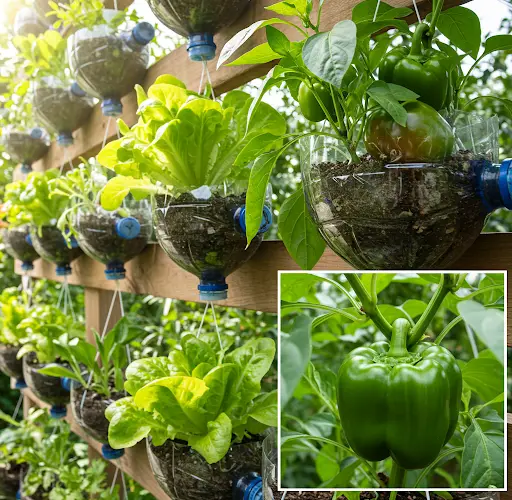Great Idea to Grow Convenient Hanging Vegetables
Growing your own vegetables at home can be incredibly satisfying, but it can also be space-consuming and time-intensive. Fortunately, there’s a clever, low-effort method that makes vegetable gardening both easy and space-efficient—hanging vegetable gardens. With just a few simple materials and minimal maintenance, you can enjoy fresh produce right outside your door, even in small spaces.
This method is especially useful for those living in urban areas or homes with limited garden space. Instead of planting directly in the ground or in large containers, you grow vegetables in hanging bags or containers. These can be suspended from balconies, fences, railings, pergolas, or any sturdy structure that gets enough sunlight. The results are not only productive but also decorative, adding greenery and charm to your surroundings.
Why Hanging Vegetables?
Hanging vegetable gardens save ground space, making them ideal for small backyards, patios, or even apartment balconies. They also improve air circulation around the plants, reducing the risk of soil-borne diseases and pests. Additionally, tending to hanging plants is easier on your back and knees—no more bending or squatting!
Certain vegetables thrive in hanging conditions, especially those with trailing vines or compact growth habits. Some popular choices include:
-
Gourds (like bottle gourds or ridge gourds)
-
Tomatoes (especially cherry or grape varieties)
-
Cucumbers
-
Peppers
-
Strawberries
-
Beans (pole varieties)
-
Herbs like mint, basil, and oregano
Gourds in particular are excellent for this method. They produce long, vigorous vines that naturally hang and climb. When grown in hanging bags, the fruits dangle freely, developing beautifully without contact with the ground, which helps them grow straighter and stay clean.
Materials You’ll Need
To start a hanging vegetable garden, you’ll need just a few items:
-
Sturdy plastic or cloth grow bags (or you can repurpose rice sacks or grocery totes with drainage holes)
-
Potting mix: A blend of compost, coco peat, and garden soil is ideal
-
Organic fertilizer: Compost, cow manure, or fermented organic fertilizer can be used periodically
-
Strong rope or hooks to hang the bags
-
Seeds or seedlings of your chosen vegetable
Make sure the spot you choose receives at least 5–6 hours of sunlight daily.
How to Set Up Your Hanging Garden
-
Prepare the grow bags: Use bags that are at least 10–12 inches deep. Poke drainage holes in the bottom and lower sides for water to escape.
-
Fill with potting mix: Fill each bag about three-quarters full with your potting mix. You can add some slow-release organic fertilizer at this stage.
-
Plant your seeds or seedlings: Place 2–3 seeds or 1 seedling per bag. If you’re planting vining vegetables, leave enough space between each bag so the vines have room to trail or climb.
-
Hang the bags: Suspend them securely using ropes, hooks, or brackets. Make sure they’re stable and won’t swing too much in the wind.
-
Water regularly: Hanging plants dry out faster than ground-level gardens, so check the soil daily and water when the top inch feels dry.
-
Feed occasionally: Use a diluted organic liquid fertilizer every 2–3 weeks to encourage growth and flowering.
-
Train the vines: As the plants grow, gently guide the vines along strings or trellises if needed. Hanging fruits will develop naturally.
Minimal Care, Maximum Yield
One of the best things about growing vegetables in hanging bags is how little maintenance they require once established. Because the containers are elevated, there’s less weed pressure and fewer pests. The fruits are easier to harvest, and the visual effect is delightful—imagine lush green vines and colorful fruits swaying in the breeze!
Many home gardeners have had great success with this method using very little attention. In fact, even with just basic watering and sunlight, gourds and other climbing vegetables tend to produce abundantly when grown vertically.
Tips for Success
-
Use quality seeds for better germination and yield.
-
Keep an eye out for pests like aphids or caterpillars; remove them by hand or spray with neem oil if needed.
-
Rotate crops after each season to avoid soil fatigue in the grow bags.
-
Add mulch like dried leaves or straw on top of the soil to retain moisture.
Final Thoughts
Hanging vegetable gardens offer a smart, space-saving way to grow your own food. With just a few bags, some soil, and a little bit of care, you can harvest fresh vegetables right at home—without needing a traditional garden. Whether you’re a beginner gardener or an experienced green thumb, this method is a fun, rewarding, and visually appealing way to cultivate healthy produce in any setting.



